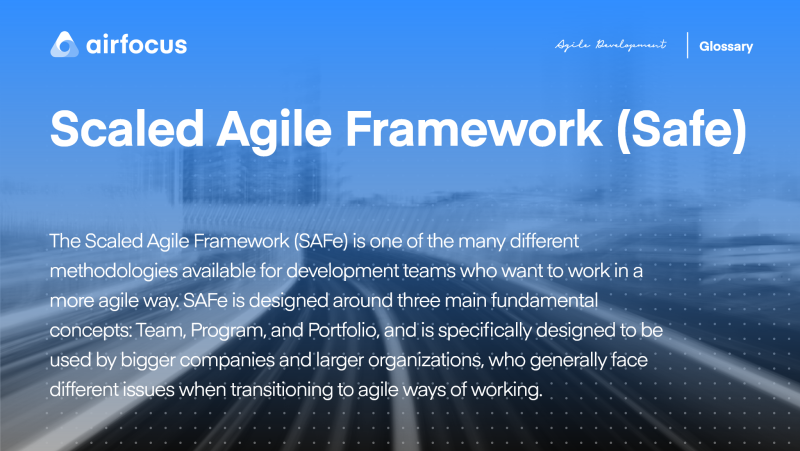Scaled Agile Framework (SAFe)
What is the Scaled Agile Framework
Definition of the Scaled Agile Framework
The Scaled Agile Framework (SAFe) is one of the many different methodologies available for development teams who want to work in a more agile way. SAFe is designed around three main fundamental concepts: Team, Program, and Portfolio, and is specifically designed to be used by bigger companies and larger organizations, who generally face different issues when transitioning to agile ways of working.
The Scaled Agile Framework (SAFe) is an incredibly malleable, flexible framework — largely because it isn’t really a fixed, specific methodology but a combination of the most successful elements and best practices of a number of other agile frameworks.
This flexibility is what makes it perfect for larger organizations who can struggle with the fast pace and hands-off nature of some agile frameworks. The Scaled Agile Framework (SAFe) almost allows companies to cherry-pick the best options for their specific needs, and allows them to use the best parts of agile even with large teams working on multiple projects simultaneously.
What’s more, by harnessing agile tools that have been demonstrated to work, larger companies can more confidently move into the agile territory.
History of the Scaled Agile Framework
Scaling agile principles to work beyond a single team has traditionally presented a challenge, and meant that larger organizations have sometimes found it hard to properly practice agile methodologies.
Over the last ten years an increasing number of frameworks and methodologies have arisen to address these challenges, and in 2011 entrepreneur and author Dean Leffingwell published ‘The Agile Enterprise Big Picture’ seeking to help find solutions to this issue.
The Big Picture took a holistic view of the workflow process, and looked at how projects progressed from product management through governance, program, and development, and eventually out to users. SAFe grew from this Big Picture view, using the principles of existing, successful agile methodologies including Scrum, Kanban, Lean and XP and applying the best practices to the three pillars of Team, Program, and Portfolio.
Benefits of using the Scaled Agile Framework
SAFe is perfect for complicated, multi-faceted projects involving multiple teams at every level of the process.
The Scaled Agile Framework (SAFe) focuses on five key competencies: encouraging leaders to drive and support change and increase the effectiveness of their team; helping teams to work quickly and efficiently while providing high-quality technical work; setting up a regular flow of completed work to keep clients satisfied; encouraging and facilitating lean systems and agile business processes; and setting up sound financial and organizational strategy.
Using and adhering to the principles of SAFe gives big companies with multiple teams the ability to engage with and leverage the methodologies in Scrum, Kanban, and other frameworks, and to scale them appropriately.
Even better, using the Scaled Agile Framework (SAFe) allows faster feedback from customers, better engagement and collaboration between clients and teams (and between teams internally), leading to a higher quality of work.
Is this Framework right for your team?
SAFe can be an exceptionally useful tool for organizations looking to step up to agile for the first time.
It’s a great way to test the waters, and its slightly more rigorous, prescriptive model helps smooth the transition for organizations who are not used to agile methodologies and ways of working already.
It’s worth noting, though, that the somewhat more planned, top-heavy aspects of management under SAFe are sometimes criticized as undermining the fundamental agile values and core principles. In fact, some agile advocates have suggested that SAFe is not a truly agile framework at all.
Nevertheless the Scaled Agile Framework (SAFe) offers great benefits for bigger companies with multiple teams wanting to benefit from agile practices. And is a great way to see if agile might work for your organization.

General FAQ

Glossary categories
Experience the new way of doing product management

Experience the new way of doing product management








